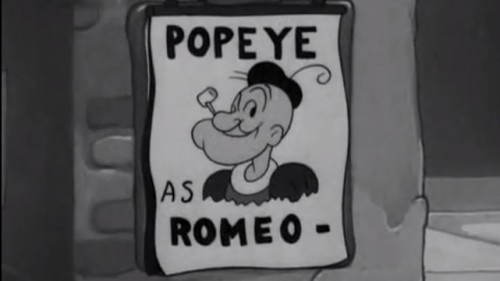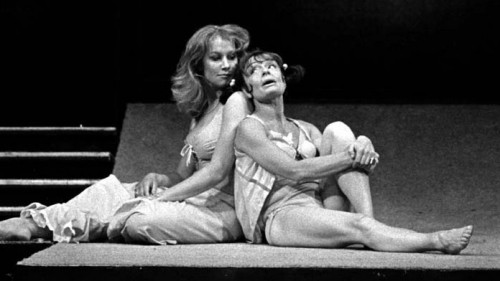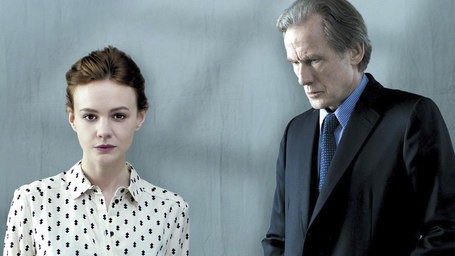9th August 2014
The Tate Britain exhibition Kenneth Clark: Looking for Civilisation closes tomorrow, Sunday 10 August. I remain thrilled to have contributed to this by curating the television extracts and writing a catalogue essay about the television programmes that Clark made for ATV between 1958 and 1966. To mark the end of this fascinating – and beautiful – display (curated by Chris Stephens and John-Paul Stonard) about a profoundly influential figure in twentieth century culture I am republishing an expanded version of a blog post that rounds up reactions to the show. read more »
8th August 2014

Following up my post about BBC Television’s 1952 experiment in abstract art, I came across a fascinating piece about the special effects system that, in its earliest form, was the inspiration of the programme. When the BBC producer Christian Simpson first met John Hoppé in 1952, the latter’s technique for projecting abstract moving images lacked a name. But less than a decade later, as a September 1960 article in Popular Mechanics shows, the process was called Mobilux and it was being used for special effects in American television. The image above is a detail from one of the photographs accompanying the piece (reproduced below); the caption reads:
Here the Hoppes co-operate, John on the head and arms, Dotte on the feet, and the result is a very realistically animated image, without the time and expense of animation, but with infinite flexibility of action.
read more »
6th August 2014

At 10.15pm on Wednesday 10 September 1952, just after an edition of the fortnightly film review show Current Release, BBC Television broadcast a 15-minute programme titled Shapes and Sounds. In its listing pages Radio Times described the transmission as ‘an experiment in light and music’, while the ‘Talk of the Week’ column explained that it was ‘designed to explore the possibilities of light patterns on the television screen’. Shapes and Sounds was produced by Christian Simpson, a fascinating figure from the early days of television, and he worked on the show with a group of artists including Rocky Stone, John Keen, Bruce Lacey, Alexis Key and Ivor Broughton.
Media studies records artists beginning to work with television in the 1960s (in the United States) and ’70s (over here). So this little discovery, which I believe is all-but-unknown to scholars (and of course no recording exists), will help re-write the history books. But perhaps it has another lesson for us as well, as the Sunday Times critic Maurice Wiggin suggested: ‘The fact that (in my opinion) the experiment [of Shapes and Sounds] did not succeed is not important. What matters is that the television authorities had the nerve to let Mr Simpson “have a go”.’ read more »
5th August 2014

Many of the world’s most prominent Shakespeare academics are meetings this week in Stratford-upon-Avon for the invite-only International Shakespeare Conference. A highlight of the first day was the screening of Shakespearian Spinach as part of the paper by Professor Peter Holland. This 1940 Paramount animation features Popeye and Olive Oyl as Romeo and Juliet – and it is rather special. Here it is as today’s treat…
4th August 2014

Tomorrow, at the final preview before Wednesday’s press night, I get to see a production that I have been looking forward to for simply ages. Maria Aberg is directing John Webster’s The White Devil in the Royal Shakespeare Company’s Swan Theatre in Stratford. So that’s one of the very greatest of all plays by one of the very smartest directors around in perhaps the best auditorium in the world. Excited, moi?
If you need an introduction to the play, the Wikipedia entry is a decent place to start. But in terms of this production, see this interview with Maria Aberg:
There is also a very good WhatsOnStage.com interview with Maria. Her production for the RSC of King John in The Swan in 2012 (go here for Peter Kirwan’s review for the Bardathon) is one of the most exciting and challenging productions of Shakespeare I’ve seen in recent years – and I have every hope that her take on Webster is as thrilling. Certainly the great set of production photographs by Keith Pattison that the RSC has just posted online suggests that this will be the case.
The RSC and Dusthouse have made a striking trailer for the show which comes with its parental advisory warning: ‘This trailer contains scenes that some viewers may find disturbing’.
More later in the week…
Image: Laura Elphinstone as Flaminio in The White Devil. Photo by Keith Pattison, courtesy Royal Shakespeare Company.
3rd August 2014

An offering including several compelling pieces about copyright (honest!). Apologies as usual to all those from whom I’ve taken tips without credit.
• What’s left to discover today? Plenty: David Bordwell as richly interesting as ever.
• L.A Plays Itself is finally coming to home video. Here’s how: Glenn Whipp for the Los Angeles Times on ‘fair use’, film clips and Thom Andersen’s 2003 video essay about the city in cinema.
• At least one real, athentic moment of humanity with Cameron Diaz: Alex Pappademas meets her for Grantland.
• Concrete nostalgia, Southmere Estate, Thamesmead: Andrea Klettner goes on a day trip for lovelondoncouncilhousing.com.
• Bullying and hypocrisy – Andy Coulson’s reign at the News of the World: more from Nick Davies’ book Hack Attack.
• Crime fiction: extraordinary journalism from Nicholas Schmidle for The New Yorker.
• Gloomy pageant: Jeremy Harding on David Marquand’s new book about Britain, for London Review of Books.
• How did Bob Dylan get so weird?: a long read from Bill Wyman for Vulture.
• Ira Glass can’t relate to Shakespeare? Good: Holger Syme at disposito.
• The Nether: not exactly a review (he hasn’t seen the show) but reflections on theatre and the virtual from Andrew Haydon at Postcards from the Gods.
• The death of privacy: Alex Preston for the Observer.
• Ways of knowing: Robert Pippin on the humanities in American universities.
• The ephemeral ebook library: fascinating piece from Sharon Farb and Sean Johnson Andrews about the ‘first sale doctrine’ and ebooks.
• The networked catalog: Matt Miller for the New York Public Library.
• Lawsuit filed to prove Happy Birthday is in the public domain; demands Warner pay back millions of license fees: … and another compelling piece about copyright, from Mike Masnick at TechDirt.
• Victory – format shifting and parody clear last hurdle: more on recent developments over copyright, from Javier Ruiz at the Open Rights Group.
• The American room: Paul Ford on another way of looking at the spaces of the States on YouTube.
• How the Commonwealth Games is helping define the future of broadcasting: Brendon Crowther at the BBC R&D blog…
• The network behind the R&D 2014 Commonwealth Games showcase: and this from the same blog but from Martin Nicholson.
Image: Summer Day (detail), Johan Hendrik Weissenbruch, c. 1870 – c. 1903, with thanks to the Rijksmuseum’s wonderful policy of allowing images from its collection to be shared and used. As for the choice… why not?
2nd August 2014

To Cinema 1 at the Barbican for a live stream of The Forbidden Zone from the Salzburg Festival. Written by Duncan Macmillan and directed by Katie Mitchell, this new work premiered last Wednesday, plays Salzburg for another week and then goes to the Schaubuhne in Berlin. (A download of the programme in English is available here.) For one night only, and to one screen only, this innovative relay came to the Barbican as a co-commission with 14-18 NOW, WW1 Centenary Art Commissions. Surprising and fascinating it most certainly was, as well as emotionally engaging.
As background, this video from 59 Productions includes rehearsal footage and an interview with Katie Mitchell:
read more »
29th July 2014

Today I went, by appointment, to what they call a carrel in Rare Books and Manuscripts at The British Library. My carrel was a little room with a glass wall, rather fierce air-conditioning and some headphones. An immensely helpful librarian explained that I should put on the headphones and she would start the playback I had requested. There had been, she admitted, a bit of a panic earlier when they discovered that the tape had been recorded more than forty years ago on a reel-to-reel machine at a very eccentric speed. But all was well. So I closed my eyes, opened my ears, and was transported back to the Aldwych Theatre on the evening of 2 January 1971. Playing out in my head was an ‘as live’ recording of The Two Gentlemen of Verona. read more »
28th July 2014

Discussions about adapting stage plays for the screen, whether broadcast live or recorded ‘as live’, have moved on apace over the past couple of months. There have also been a number of further cinema broadcasts, including a successful presentation by NT Live of David Hare’s Skylight, of which Encore screenings are continuing. Below are some recent readings about this question.
• Let’s stop pretending that theatre can’t be captured on screen: this Michael Billington Guardian piece (18 June 2014) is something of a game-changer:
I went this week to a preview of Digital Theatre‘s screen version of Richard Eyre’s Almeida production of Ibsen’s Ghosts: I can only say that it offered an experience comparable to that I had in the theatre… while I remain an evangelist for live theatre, I think it’s time we stopped pretending that it offers an unreproducible event. A theatre performance can now be disseminated worldwide with astonishing fidelity.
• Sir Alan Ayckbourn voices fears over theatre screenings: the playwright offers a note of scepticism; from BBC online, 11 June 2014.
• NESTA research finds that National Theatre Live has no negative impact on regional theatre-going: outline from The Audience Agency on the research undertaken with NESTA; 25 June 2014.
• Research finds that National Theatre Live has no negative impact on regional theatre-going: this is NESTA’s press release; 24 June 2014…
• NESTA Working Paper 14/04: … and this is a download of the report in full.
• How live cinema screenings can help boost live arts audiences: Arts Council Chair Peter Bazalgette adds his gloss to the research; from the Independent, 30 July 2014.
• New work needs to be done before cinema broadcasts bring new audiences to opera: the focus is different, but this English Touring Opera research is also a valuable contribution to the debates; this is their 27 May 2014 blog piece…
• English Touring Opera – Opera in cinemas research: … and this is a download of the paper in full.
• The bitter taste of live screening: Elizabeth Freestone raises some important questions about live cinema broadcasts; from Arts Professional, 5 June 2014.
• Coney’s no island – could streamed theatre let audiences call the shots?: Andrew Haydon for the Guardian on Coney’s interactive theatre experiment Better than Life; 1 July 2014.
• Of Mice and Men to be National Theatre’s first live Broadway screening: meanwhile, NT Live is expanding its geographical reach to take in a New York show; this is the BBC’s 25 July news report. Screening dates for the ‘as live’ recording have still to be announced.
The next RSC Live from Stratford-upon-Avon cinema broadcast is Simon Godwin’s sparkling and totally delightful production of The Two Gentlemen of Verona on 3 September; details here.
26th July 2014

Welcome home – to sunshine, a much-neglected blog and more than 1,700 spam comments that need (rapid) reviewing. Here is a developing list of some of the things I’ve found interesting in the past few days since I have been back from a wonderful time in Italy. With apologies for not giving credit where it’s due for the pieces I didn’t discover myself.
• NOW THEN: a new batch of brilliance from Adam Curtis.
• The down and dirty history of TMZ: a completely compelling profile of the above by Anne Helen Petersen for Buzzfeed.
• The pervasive power of Rupert Murdoch: an extract from Hack Attack by Nick Davies, courtesy of the Guardian.
• ‘Hollywood Exiles in Europe’ – feeling alienated and anxious: Kenneth Turan for the Los Angeles Times on a UCLA season of movies made by those who driven away by the Red-baiting of the 1950s.
• Excerpt from Crying at the Movies: a section of Marion Sprengbether’s ‘film memoir’, published in 2002.
• Insomnia – unbearable lightness: Jonathan Romney for Criterion on the 1997 Norwegian thriller.
• Moonrise Kingdom – Wes in Wonderland: David Bordwell on current notions of auteurism as highlighted by Anderson’s film.
• Hollywood transformed: Tom Shone for the Financial Times on China and the contemporary cinema.
• Edinburgh 2014 – brain benders of the Black Box: Harriet Warman for Sight & Sound at the EFF showcase of experimental moving images.
• Andrew Dickson on Shakespeare in the Wild West: great podcast.
• The Nether “trailer”: a smart interactive experience for the show currently at the Royal Court.
• Mastersinger: Alex Ross profiles Joyce DiDonato for The New Yorker.
• The all-American expo that invaded Cold War Russia: Matt Novak at Paleo-future on the American National Exhibition in Moscow, July 1959.
• Prefab, post fab and just fab: John Grindrod visits Catford’s Excalibur Estate of post-war pre-fabs.
• No moral, no uplift, just a restless ‘click’: Holland Cotter at The New York Times on MoMA’s Garry Winogrand retrospective…
• In transit: … and a very fine Geoff Dyer piece on Winogrand from the London Review of Books archives.
• Musical gold: a fine Rebecca Mead New Yorker piece on investing in Stradivari.
• Brief lives: Luke McKernan on writing for the Oxford Dictionary of National Biography (which I’ve also been doing recently)
• At the crime scene: a remarkable London Review of Books essay by Adam Shatz on the sado-masochism (and more) of Alain Robbe-Grillet.
• What is the great American novel?: for TLS Sarah Graham reviews Lawrence Buell’s The Dream of the Great American Novel.
• Big air: The New Yorker‘s Ben McGrath at the X Games.
• BBC R&D at the Commonwealth Games 2014: the future of broadcasting is here – or, at least, it’s in Glasgow.
• Beyond digitisation – new possibilities in digital art history: James Cuno for Iris at The Getty.
• Citizen Bezos: Steve Coll on Amazon for The New York Review of Books.
• Understanding the participatory culture of the web – an interview with Henry Jenkins: … by Trevor Owens at a Library of Congress blog.








